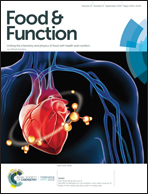Evaluation and structure–activity relationship analysis of antioxidant shrimp peptides
Abstract
The effects of amino acids Gln and Lys on the antioxidant ability of peptides were investigated in this study. The identified peptides Lys-Met-Asp-Asp-Lys (KMDDK), Lys-Met-Asp-Asp-Gln (KMDDQ), Gln-Met-Asp-Asp-Lys (QMDDK), and Gln-Met-Asp-Asp-Gln (QMDDQ) were used to investigate their antioxidant activity and the structure–activity relationship by using UPLC-Q-TOF-MS, flow cytometry, laser scanning confocal microscopy and 1H NMR spectroscopy. The results indicated that the four pentapeptides significantly increased the viability of PC12 cells and inhibited cell apoptosis and that QMDDQ possessed a stronger survival activity than the others in cell apoptosis. Moreover, the four peptides significantly decreased the scopolamine-induced ROS and LDH content in PC12 cells, and upregulated the SOD activity to the level of the scopolamine group. The DPPH and hydroxyl radical scavenging of QMDDQ were higher than those of the other peptides at 0.5 mg mL−1 and 1.0 mg mL−1 (P < 0.05). 1H NMR spectra revealed that the prominent antioxidant ability of QMDDQ might be attributed to more active hydrogen sites and functional groups. The carboxyl active hydrogen atoms and amino active hydrogen atoms as active sites play a critical role in the antioxidant capacity.



 Please wait while we load your content...
Please wait while we load your content...